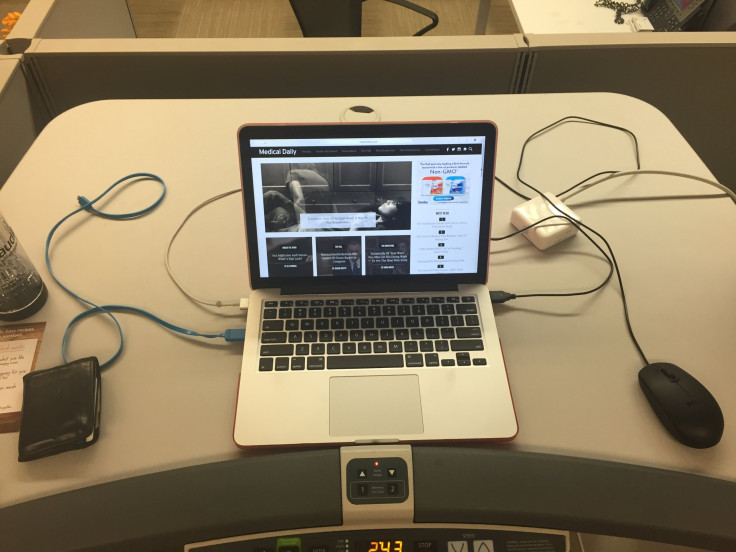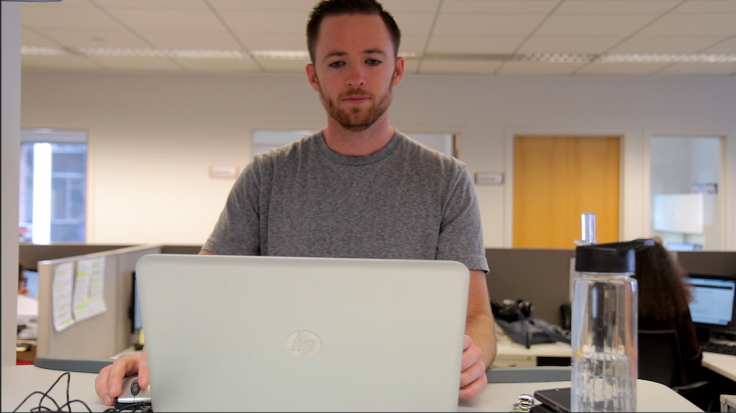MD Tech Review: What It's Like To Use LifeSpan's Treadmill Desk For Hours While You Work

As someone who works out for an hour a day, five days a week, and who averages more than 10,000 steps each day (according to my Fitbit), I consider myself decently fit. That’s despite sitting for nearly the entire day. I spend four hours on my round trip commute in a seat, with an additional eight hours of sitting at work in between. Then when I get home, I normally park myself in front of the TV and watch until it’s time for bed.
All this sitting isn’t good. As you’ve probably heard by now, it’s risky business. Sitting for long periods constitutes what’s known as sedentary behavior, defined as any time a person sits or lies down without expending much energy. Earlier this year, a study from the Physical Activity Council found the number of physically active Americans hit a new low in 2014. With this lack of exercise, these people are at greater risk of becoming obese (their diets certainly don’t help, either) and subsequently developing a wide range of diseases, like heart disease, diabetes, cancer, kidney disease, and non-alcoholic fatty liver disease, all of which could lead to an early death. Over a third of American adults are already on this path.
In an effort to combat this, more companies have begun allowing employees to use standing desks in their offices (including Medical Daily). But even these might not be as effective at warding off the effects of sitting for eight hours a day — maybe a treadmill desk would be better. So, when treadmill desk-maker LifeSpan offered me a chance to try out its most popular model, the TR1200-DT7, I jumped on it.
If you’re wondering what a treadmill desk looks like, it’s essentially a treadmill with a tall desk attached to it. The desk is plenty wide, providing ample space for my old, monstrous laptop and mouse, a water bottle, and other random items that gradually found their way onto it.
The treadmill, meanwhile, is just like any other treadmill you’ve seen before. Its speed ranges from an agonizing, awkwardly slow 0.4 miles per hour to a somewhat brisk 2 miles per hour. It can also track your time spent walking, steps taken, calories burned, and distance traveled. And then this information can be uploaded directly to your Android device via Bluetooth — iOS capabilities are still in the works.
That being pretty cut and dry, here’s how my month of walking and working went:
Using The Treadmill
When the guys at LifeSpan dropped off my desk, their National Workplace Manager, Rick Leith, told me the average person who uses it typically walks at a speed between 1.2 and 2 miles per hour. So I heeded Leith’s advice and started walking 1.2 miles per hour. Now, like I said, I normally reach a fair amount of total steps over the course of the day, so it was surprising when my legs became tired after barely an hour of walking. In my excitement over using the new desk, I hadn’t considered all those steps, when condensed into a four-hour time span, were a lot of work.
So I began getting used to the desk, slowly ramping up my speed and the hours I spent walking. Each day, I bumped up the speed a little bit, and eventually I was cruising along at 2 miles per hour. I was taking more steps, walking more miles, and burning more calories. It felt great, even if it didn’t last too long. After about three days of walking this speed for an hour or two each day, I began to notice my work was suffering.

Completing basic tasks, like reading and typing, weren’t difficult at 2 miles per hour. But concentrating on writing and keeping pace on the treadmill was. Multitasking, in general, requires the brain to split its resources between various tasks, which makes it difficult to focus attention altogether. So it made sense that some of my mental energy, which would otherwise go toward writing, was being spent on keeping pace. To compensate, I slowed the treadmill down to a more manageable 1.4 miles per hour, and it’s there that I found my sweet spot.
Now, able to walk and work, I truly began to see the benefits of the treadmill desk. My legs became accustomed to the constant motion as I spent more time on it. They grew stronger, which allowed me to eventually walk for four hours a day with minimal discomfort. As I got used to the way my shoulders moved while walking, I got better at typing and using my mouse accurately — I was no longer getting frustrated from highlighting the wrong text or clicking on the wrong link.
My arms and hands were never in pain when I typed either, as Leith showed me how to adjust the height of the desk to ensure my arms sat at 90-degree angles. There was also a soft pad to rest my wrist, similar to the ones you see in front of desktop keyboards. It was a lot more comfortable than I thought it would be at first glance.
The Benefits I Noticed
With my treadmill legs under me, I was walking for at least four hours, five days a week. I had stopped doing leg workouts because the treadmill was already enough exercise, and I came into work excited to get started on it.
After about two weeks I started noticing results; my legs looked more toned than they had ever been. I used my Fitbit during the process to track my overall steps, and found I was crushing my friends’ daily step counts — getting around 30,000 steps each day, more than double the next highest average. This only made me happier.

I also ran a 5K race one morning after two weeks of walking. I hadn’t trained for it at all. In fact, I had barely done any cardio training since getting the desk. But I completed the race with my fastest time in years. And while I can’t scientifically prove the desk helped me with the race, I’m going to say it did.
It wasn’t only me who noticed the effects of the treadmill desk. As the month progressed, everyone from my dad to friends I’ve known for 20 years kept asking if I’d lost weight. “Hey, why are you so skinny these days?” one friend asked. At first I said I didn’t lose any weight whatsoever, although I did feel trimmer. Yet upon checking my weight at the end of the 21 days, I found it hadn’t changed at all from what it was at the beginning of the experiment. I was still 171 pounds.
The Benefits, According To A Doctor
Dr. David Sabgir is a practicing cardiologist in Columbus, Ohio and founder/CEO of Walk With a Doc, a nonprofit with a mission to “encourage healthy physical activity in people of all ages, and reverse the consequences of a sedentary lifestyle.” He told me that as bad as sitting can be for your health, standing still all day can be just as detrimental. “Standing just is not as good [as walking],” Sabgir said. “Getting blood moving provides countless benefits to activity, increased energy, and creativity.”
A treadmill desk user for nearly a year now, Sabgir finds plenty of benefits in both how a treadmill desk helps him with his job and how it helps the overall fitness of each patient he sees. Personally, Sabgir believes walking on his treadmill desk gives him the creativity he needs to write a weekly tongue-in-cheek newsletter about Walk With a Doc. He also uses his treadmill desk as a way to relieve stress; if he finds himself mad or upset, he hops on the desk and walks his troubles away.
As for the clients that Sabgir treats, he’s found those who are obese or have heart problems can benefit from a walking program. Treadmill desks also help them achieve the goal of 10,000 steps a day. Sabgir told Medical Daily that Americans average about 3,000 to 3,500 steps a day; only 5 percent of the country gets the recommended 10,000 steps per day.
Getting a treadmill desk, counting your steps, or simply walking for 30 minutes every day can “help protect against metabolic syndrome, abdominal fat, diabetes, low blood sugar, high blood pressure, heart disease, and depression,” Sabgir said. That doesn’t mean a treadmill desk is a an effective weight-loss device, but Sabgir said “absolutely, people suffering from obesity or heart problems would benefit from [a treadmill desk].”
I mentioned to Sabgir that I sit for four hours a day during my commute, and asked if I was at risk for health problems. He reassured me that even moderate, frequent exercise — moving just two to three minutes every hour, “aiming for 150 minutes a week” — can be beneficial to those with long commutes, as it’ll help combat the symptoms of a sedentary lifestyle.
As for how a beginner should go about using a treadmill desk, Sabgir suggested that you “know your speed, go at a moderate pace, and try not to exceed 300 minutes a week (after which time the benefits start to diminish).” In doing so, “you’ll be getting all the [health] benefits of simply not sitting,” he said.
The Market For Treadmills Desks
LifeSpan President Peter Schenk, who was nice enough to grant Medical Daily an interview to discuss the finer points of the emerging treadmill desk market, said that initially, “early adopters were highly educated people like lawyers or doctors.” This was in 2012, when LifeSpan first started selling treadmill desks. However, as they became more popular, smaller companies began ordering a desk or two for their office. “These companies would buy them for a single executive, or set up a communal desk for everyone to use for set times during the day,” Schenk said.
Fast forward to today and larger companies are beginning to realize employees who are physically active during the day are more productive and overall healthier. Schenk found that only a few people would use the desk when one was sent to a company. But when these companies received more than one, he said they “were always in use and in such high demand that they would have to set up time restrictions to make sure everyone got a chance to walk.” Leith echoed this sentiment when he delivered the desk on my first day walking on it.
The Future Of Treadmills Desks
While people are increasingly becoming health conscious in every aspect of their lives, it might still be some time before treadmill desks are the norm and employees are no longer sitting while they work. “I have yet to see a company that has adopted a fleet of treadmill desks for their employees,” Schenk said.
The future of treadmill desks is bright, however, as Schenk looks to increase efforts to push treadmill desks into larger corporations, universities, home offices, and more. Right now, he sees about 80 percent of them going to offices, while the other 20 percent go to the home office — this probably isn’t going to change anytime soon, he said.
But who’s really to say how offices will look in the next 10, 15, or 20 years? Schenk is open to implementing different types of exercise equipment into the office — LifeSpan currently has a communal circular desk that holds three stationary bikes. And with the rise of wearables and mobile health apps, it could be only a matter of time before everyone is moving while working, and leading healthier lives because of it.
And Now My Walk Has Ended…
Over the course of the 21 days I spent using the treadmill desk, I walked for more than 85 hours, took close to 400,000 steps, burned more than 1,000 calories a day on average, and traveled a little more than 117 miles in one spot.
After all this, would I do it again? Absolutely. I have recommended LifeSpan’s treadmill desk to anyone and everyone who would listen. Now, however, I have a treadmill desk-sized hole in my heart and a daily step count that might never be filled again. I dread the coming days where I’m anchored to my desk.

Published by Medicaldaily.com



























